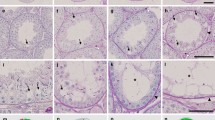Abstract
A concept for the computer-assisted visualization of tubular organs is presented. Unmarked histological zinc-stained serial sections from the epididymis of the Wistar rat were aligned to demonstrate the concept. Virtual images were made through the aligned sections and served as controls for the alignment process. Animation of the serial sections and the virtual images revealed new information about the structure of the organ under investigation. The analysis was used to upgrade the anatomical knowledge of rat epididymis by describing how the epididymal duct runs through the structure. The proximal parts of the epididymis contain large communicating septa of connective tissue dividing the caput and the upper part of the corpus epididymidis into segments. The tortuousness was high in the caput with many turns within a small area of the epididymis, whereas longer loops were found in the lower part of the corpus and cauda epididymidis. The tube of the vas deferens was found to become an integrated part of the ductal system in the cauda epididymidis, although it was histologically easy to distinguish from the epididymal duct. The total number of cross-sections of the ductus epididymidis in the 2254, 15-mu m-thick, tissue sections analysed was 104 700, giving a minimum length of the ductal system of 1.5 m. © 1998 Chapman & Hall
Similar content being viewed by others
References
Andreasen, A., Drewes, A.M., Assentoft, J.E., Larsen, N.E., Nielsen, H., Holm, I.E. & Geneser, F.A. (1991) Computer-assisted three-dimensional reconstruction of the hippocampal region based on serial sections. J. Neurosci. Methods 37, 151–60.
Andreasen, A., Drewes, A.M., Assentoft, J.E. & Larsen, N.E. (1992) Computer-assisted alignment of standard serial sections without artificial landmarks. A practical approach to the utilization of incomplete information in 3-D reconstruction of the hippocampal region. J. Neurosci. Methods 45, 199–207.
Benoit, M. J. (1926) Recherches Anatomiques, Cytologiques et Histophysiologiques sur les Voies Excrétrices du Testicule, chez les Mammifeères. Strasbourg: Les Éditions de la Librairie ´Union', pp. 175–412.
Blackstad, T.W., Karagulle, T., Malmierca, M.S. & Osen, K.K. (1993) Computer methods in neuroanatomy: determining mutual orientation of whole neuronal arbors. Comput. Biol. Med. 23, 227–50.
BrÄndle, K. (1989) A new method for aligning histological serial sections for three-dimensional reconstruction. Comput. Biomed. Res. 22, 52–62.
Danscher, G. (1981) Histochemical demonstration of heavy metals: a revised version of the sulphide silver method suitable for both light and electronmicroscopy. Histochemistry 71, 1–16.
Feng, C., Liu, L., Liu, S., Ning, H., Sun, H. & Guo, A. (1995) Three-dimensional structure of CA1 pyramidal cells in rat hippocampus-optical recording of LSM and computer simulation of fractal structure. Sci. China B 38, 1187–94.
Fujimori, O., Tsukise, A. & Yamada, K. (1971) Histochemical demonstration of zinc in rat epididymis using a sulphide silver method. Histochemistry 88, 469–73.
Gerke, M., Schü tz, T. & Kretschmann, H.-J. (1992) Computer-assisted 3D reconstruction and statistics of the limbic system. 1. Computer-assisted 3D reconstruction of the hippocampal formation, the fornix, and the mammillary bodies. Anat. Embryol. 186, 129–36.
Hemeida, N.A., Sack, W.O. & Mcentee, K. (1978) Ductuli efferentes in the epididymis of boar, goat, ram, bull, and stallion. Am. J. Vet. Res. 39, 1892–900.
Huijsmans, D.P., Lamers, W.H., Los, J.A. & Strackee, J. (1986) Towards computerized morphometric facilities: a review of 58 soft ware packages for computer-aided three-dimensional reconstruction, quantification and image generation from parallel serial sections. Anat. Record 216, 449–70.
Jiang, F.X., Temple-Smith, P. & Wreford, N.G. (1994) Postnatal differentiation and development of the rat epididymis: a stereological study. Anat. Record 238, 191–8.
Manely, R.B. (1959) Epididymal structure and function. A historical and critical review. Acta Zool. 40, 1–21.
Park, Y.S., Abe, M., Takehana, K. & Iwasa, K. (1993) Three-dimensional structure of dog Sertoli cells: a computer-aided reconstruction from serial semi-thin sections. Arch. Histol. Cytol. 56, 65–73.
Reisner, A.H., Bucholtz, C.A., Bell, G.A., Tsui, K.T., Rosenfeld, D. & Herman, G.T. (1990) Two-and three-dimensional image reconstructions from stained and autoradiographed histological sections. CABIOS 6, 253–61.
Robaire, B. & Hermo, L. (1988) Efferent ducts, epididymis, and vas deferens: structure, functions and their regulation. In The Physiology of Reproduction (edited by Knobil, E. & Neill, J. ), pp. 999–1079. New York: Raven Press.
Saito, S., Bush, I.M. & Whitmore, W.F. (1967) Effects of certain metals and chelating agents on rat and dog epididymal spermatozoan motility. Fertil. Steril. 18, 517–29.
Saitoh, K., Terada, T. & Hatakeyama, S. (1990) A morphological study of the efferent ducts of the human epididymis. Int. J. Androl. 13, 369–76.
Schell, H. & Hornstein, O.P. (1974) über den histochemischen Nachweis von Zink im menschlichen Nebenhoden. Acta Histochem. 48, 232–56.
Stoltenberg, M., Ernst, E., Andreasen, A. & Danscher, G. (1996) Histochemical localization of zinc ions in the epididymis of the rat. Histochem. J. 28, 173–85.
Stoltenberg, M., Sèrensen, M.B. & Danscher, G. (1997) Histochemical demonstration of zinc ions in ejaculated human semen. Int. J. Androl. 20, 229–36.
Stoltenberg, M., Andreasen, A., Jensen, K.B., Juhl, S., Danscher, G. & Ernst, E. (1998) PC-assisted three-dimensional description of organs containing tubular structures. Applicated on the epididymis of the rat. Comput. Med. Image Graphics (in press).
Togawa, Y., Kano, K., Goto, K. & Sato, S. (1981) Three dimensional structure of the human epididymis. Arch. Histol. Jap. 72, 597–600.
Winslow, J.L., Bjerknes, M. & Cheng, H. (1987) Three-dimensional reconstruction of biological objects using a graphics engine. Comput. Biomed. Res. 20, 583–602.
Author information
Authors and Affiliations
Rights and permissions
About this article
Cite this article
STOLTENBERG, M., THERKILDSEN, P., ANDREASEN, A. et al. Computer-assisted visualization of the rat epididymis: a methodological study based on paraffin sections autometallographically stained for zinc ions. Histochem J 30, 237–244 (1998). https://doi.org/10.1023/A:1003255705503
Issue Date:
DOI: https://doi.org/10.1023/A:1003255705503




